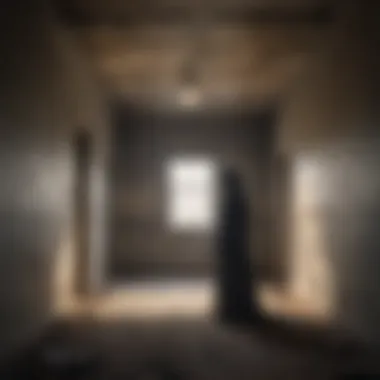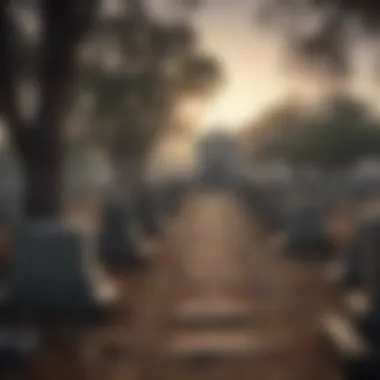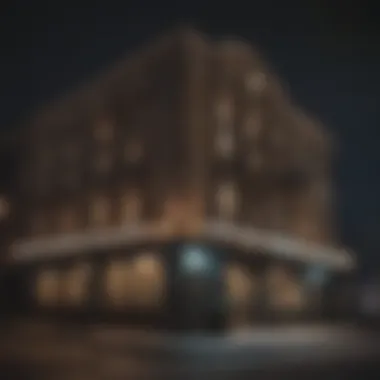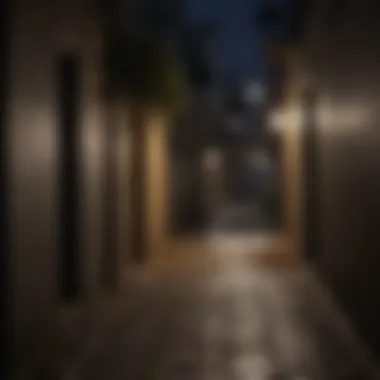Unearthing San Diego's Most Haunted Locations


Intro
San Diego, often celebrated for its sunny weather and coastal beauty, holds a more shadowy aspect beneath its surface. From ghostly apparitions to unexplained noises, the city is rich with tales that captivate the imagination. These haunted locations tell stories intertwined with history, revealing remnants of the past that haunt the present. In this article, we will embark on a journey through San Diego's most notoriously haunted sites, uncovering their stories, the historical significance, and the eerie encounters reported by visitors and locals alike.
Understanding these haunted places is not merely about seeking thrills; it is about connecting the dots between history and folklore. By exploring each site, we intend to provide deeper insights into the interplay between the cultural narratives and the myths that have developed over time. Whether you are a skeptic or a believer in the supernatural, this guide aims to shed light on the unique features that make San Diego a hub for paranormal enthusiasm.
Prepare to explore the hidden corners of a city that combines vibrant life with spectral history.
Foreword to Haunted Locations
Exploring haunted locations provides an intriguing glimpse into the intersection of history and folklore. San Diego, with its rich past and diverse communities, presents numerous sites steeped in tales of the supernatural. Understanding these locations is not merely about thrill-seeking; it is a way to appreciate the cultural narratives that shape local identities. Haunted places often serve as a reflection of societal values, fears, and historical events, allowing visitors to connect with a deeper collective consciousness.
Understanding the Concept of Haunted Places
The term ‘haunted’ refers to locations where individuals report experiencing unexplained phenomena. This could include sightings of apparitions, inconsistent temperatures, or unusual sounds. While some may dismiss these accounts as mere myth, each story offers a window into the emotions and histories intertwined with the space. Haunted places can evoke curiosity, fear, or even a sense of nostalgia. They often encourage dialogues around unresolved issues, whether they are related to tragedy, loss, or cultural memory.
In many cultures, the concept of haunting intertwines with spiritual beliefs. For some, it is a comforting thought that the dead remain close by, while others fear the unknown associated with these entities. Thus, exploring these themes can yield insights into human behavior and social responses to death and grief.
The Intersection of History and Haunting
The history of a location is often documented through events, people, and cultural changes that shape the narrative of those who inhabit it. Hauntings frequently stem from significant historical events. For instance, a site that served as a battleground or a home to tragic life stories may become a container for those memories, manifesting in ghostly tales. Understanding this connection is vital in grasping the essence of haunted sites.
Moreover, the significance of these places can evolve over time. New generations may reinterpret past events, leading to contemporary hauntings influenced by modern attitudes and beliefs. It is crucial to recognize that these hauntings are not static; they adapt alongside the narratives of people who engage with them. The relationship between history and haunting thus becomes a dynamic dialogue, one that deserves exploration in its full context.
“History is written by the victors,” but hauntings often tell the stories of the forgotten.”
With San Diego's blend of various historical layers, from colonial times through the influence of indigenous cultures, the haunting tales in this region are particularly rich and varied. Each location offers an opportunity to learn and reflect on how the past reverberates in the present. The complexities of these narratives enrich not just the understanding of haunted places, but also the cultural fabric of the city itself.
Historical Context of San Diego
Understanding the historical context of San Diego is crucial to grasp the eerie allure of its haunted locations. This city, with its rich past, holds stories that intertwine culture, tradition, and the supernatural. By studying these elements, one can appreciate how history shapes the narratives that persist today. Events and experiences from the past often resonate in contemporary times, adding depth to the haunting tales. The blend of colonial and indigenous history in San Diego enriches the city's essence, making it particularly noteworthy for those fascinated by the supernatural.
San Diego’s Colonial Past
San Diego’s history began with its establishment as a Spanish mission in 1769. This was significant as it marked the first European settlement on the West Coast of the United States. The initial mission, known as Mission San Diego de Alcalá, was a focal point for religious conversion as well as governance of the area. The harsh realities of colonial life left a lasting impact and shaped the interactions between the Spanish settlers and native people.
Many of the locations we now identify as haunted have roots in this colonial era. For instance, violence, disease, and conflict were prevalent during this time, often leading to tragic endings. The presence of spirits from this painful past has contributed to the ghost stories tied to these historic sites. Visitors recount tales of eerie whispers and shadows, suggesting that remnants of colonial struggles remain in these places.
Influence of Indigenous Cultures
The indigenous cultures of San Diego, specifically the Kumeyaay people, have a profound influence on the region's history and its haunted narrative. Long before colonial powers arrived, the Kumeyaay thrived in the area, developing a rich array of traditions, beliefs, and practices. Their profound connection to the land informs the supernatural stories that local residents share.
Some believe that places significant to the Kumeyaay culture, such as ancient ceremonial sites and burial grounds, continue to resonate with spiritual energy. The stories that emerge from these locations often reflect a struggle for survival and a deep respect for the natural world. Additionally, the blending of indigenous and colonial narratives can create a haunting tapestry. Experiences reported at these historical spots often reflect this intersection of histories, raising questions about territorial respect, cultural memory, and the ghosts of those who came before.
The past is not dead; it is not even past. This sentiment echoes through San Diego’s haunted locales, where echoes of history often meet the present.
Through understanding both the colonial and indigenous influences, visitors can better appreciate why San Diego's haunted locations captivate those intrigued by the supernatural. Each site tells a story, rich with complexity and layered meanings that both challenge and illuminate our understanding of the past.
Key Haunted Locations in San Diego
The exploration of key haunted locations in San Diego is significant as it provides insights into the city’s rich history and intriguing folklore. Each haunted site carries stories and tales that connect the present with the past, enhancing the understanding of local culture and beliefs. Recognizing these locations enables residents and visitors alike to appreciate the interplay between history and the supernatural, fostering a broader perspective on local heritage.


The Whaley House
Historical Background
The Whaley House is notable for its role in early San Diego history. Built in 1857, it was the first brick building in the area and served multiple purposes, including a residence, commercial space, and a courtroom. Its historical significance contributes heavily to its haunted reputation, making it an essential inclusion in this article. The architectural style and decor remain reflective of that period, capturing the essence of 19th-century life in San Diego, which attracts those interested in both history and the paranormal. Its narrative intertwines with local lore about those who lived and died in the house, a key characteristic that enriches the visitor experience.
Reported Hauntings
Reported hauntings at the Whaley House include sightings of apparitions, unexplained noises, and other supernatural occurrences. The house is said to be haunted by members of the Whaley family and others associated with the property. These haunting tales contribute significantly to the house’s mystique, making it a popular destination for ghost hunters and history enthusiasts. The combination of firsthand accounts and ongoing investigations into the paranormal activities provides compelling narratives that further engage visitors. However, these reports can sometimes blur the lines between myth and reality, prompting critical thinking about personal experiences versus documented history.
Visitor Experiences
Visitor experiences at the Whaley House offer testimonies that range from eerie to enlightening. Many guests report feeling a distinct atmosphere, as if they are being watched or accompanied by unseen presences. The guided tours often share stories that heighten the thrill and deepen the connection to history. While such experiences can be captivating, they can also lead to skepticism among those seeking empirical evidence. This dual nature of visitor reports showcases the unique feature of the Whaley House as a site that encourages personal interpretation and reflection on the supernatural versus the historical.
El Campo Santo Cemetery
Founding and Purpose
El Campo Santo Cemetery, established in the late 19th century, was created as a resting place for those who significantly contributed to the development of the early San Diego community. The cemetery holds a rich history that speaks to the area’s cultural diversity, serving as a final resting place for both notable figures and ordinary citizens. This historical depth adds layers of significance to its status as a haunted site. Visitors often reflect on the lives of those buried there, connecting the present with lasting legacies of the past.
Paranormal Reports
Paranormal reports associated with El Campo Santo Cemetery include sightings of wandering spirits and unusual phenomena experienced during nighttime visits. Various accounts highlight spectral figures and sudden temperature drops, contributing to the cemetery’s reputation. These reports serve as interesting commentary on human curiosity and the desire to understand the unknown. They reinforce the cemetery’s position as a haunted location, where visitors come not only to pay respects but also to experience the unexplained.
Significance in Local Folklore
The significance of El Campo Santo in local folklore is profound. Stories passed down through generations about the restless spirits interred there have become a part of San Diego's cultural narrative. Through these tales, the community connects with its history in a meaningful way, bridging the past with contemporary beliefs about the supernatural. This folklore serves as a fascinating layer that enhances the understanding of the cemetery’s role within the local tradition, making it a relevant topic for this article.
Hotel del Coronado
History of the Hotel
Hotel del Coronado, known for its iconic Victorian architecture, has been a prominent figure in San Diego since its opening in 1888. The hotel has housed numerous notable guests, contributing to its historical prominence. Its lavish design and unique history play a critical role in its haunted reputation, attracting those interested in both luxury and the mysterious past of the establishment. The blend of opulence and supernatural encounters makes it a compelling addition to the list of haunted locations in San Diego.
Legend of Kate Morgan
One of the most well-known legends associated with Hotel del Coronado is that of Kate Morgan, who mysteriously died on the property in 1892. Her story has become intertwined with the hotel’s identity, leading to numerous ghost sightings and reports of eerie happenings. The compelling nature of this legend captivates many and solidifies the hotel’s status as a haunted destination. It not only engages tourists but also sparks interest in historical truth versus folklore.
Contemporary Ghost Sightings
Contemporary ghost sightings at Hotel del Coronado continue to intrigue both staff and guests. Reports include sightings of a woman in a white dress, believed to be Kate Morgan, along with various unexplained sounds and occurrences. Such experiences add a thrilling layer to the hotel experience. However, they also provoke discussions about the nature of belief and the interpretation of these sightings in a modern context, highlighting the ongoing relevance of ghost stories in today’s society.
The Gaslamp Quarter
Cultural Significance
The Gaslamp Quarter is not just a vibrant district filled with nightlife; it also serves as a historical epicenter of San Diego. Established in the late 1800s, its streets have seen significant events, contributing to the character of the city. This rich cultural backdrop enhances its haunted reputation, making it an attractive spot for those interested in history and ghostly tales, tying past events to the present through stories of hauntings.
Haunting Tales
The Gaslamp Quarter offers a myriad of haunting tales, many tied to its flamboyant past and the individuals who lived and worked there. Various establishments report paranormal activities, making the area a treasure trove of eerie stories. These tales add a vibrant element to the cultural narrative of the district. While some stories seem whimsical, they prompt deeper investigation into the origins of such accounts and their enduring impact on the community.


Modern-Day Impact
The modern-day impact of the Gaslamp Quarter's ghost stories extends beyond tourism. These narratives shape how residents and visitors perceive the area, infusing it with a charm and mystique that enhances its allure. Businesses often incorporate these tales into marketing strategies, bridging the gap between entertainment and historical appreciation. This interwoven relationship between the past and present illustrates the significant role that cultural narratives play in urban life.
Mission San Diego de Alcalá
Foundational History
Mission San Diego de Alcalá, founded in 1769, is the first of California’s missions and holds a crucial place in the state’s history. Its founding marked the beginning of Spanish influence in the region, setting the stage for future developments. The mission’s extensive history speaks to themes of exploration, settlement, and cultural encounters. This foundational aspect emphasizes its relevance in exploring hauntings and their connections to local heritage.
Supernatural Accounts
Supernatural accounts at Mission San Diego de Alcalá share tales of apparitions and unexplained happenings, often linked to the tumultuous events surrounding its history. These narratives resonate with visitors and pilgrims who seek a deeper connection to the past. The blending of religious history with ghostly tales adds richness to the mission's identity, creating a unique experience for those who visit.
Connection to Native Heritage
The connection to Native heritage at Mission San Diego de Alcalá reveals a complex narrative of cultural sacrifice and resilience. Stories of the Native Americans impacted by the mission system reinforce the site’s significance in both history and ongoing discussions about heritage. The acknowledgment of this connection enriches the exploration of hauntings, transforming them from mere ghost stories into powerful narratives that reflect broader social themes.
The Research Behind Haunted Sites
Examining haunted locations requires a blend of history, folklore, and personal experiences. The research behing haunted sites clarifies how these urban legends emerge and how they are preserved over time. Understanding this topic is vital in dissecting the tales attached to San Diego’s most infamous places. The documented experiences and historical events often contribute to a narrative that enriches our comprehension of the past.
Historical Documentation
Historical documentation serves as a cornerstone for understanding haunted sites. Various records exist, including newspaper articles, diary entries, and government documents. These sources provide factual details about incidents that took place at certain locations. For instance, the Whaley House's rich history is enlivened by its recognition as a California Historical Landmark.
Research into historical documentation offers insights into the lives of those who once inhabited these spaces. It reveals the socio-political climate of the times and how events, both mundane and tragic, potentially lead to later claims of hauntings. However, the credibility of these historical records can vary. Hence, researchers must approach them critically, ensuring that the facts align with the folklore that has developed over time.
Eyewitness Accounts
Eyewitness accounts hold significant weight when exploring haunted locations. These narratives often emerge from individuals who have experienced unusual occurrences firsthand. In San Diego, many visitors to the Gaslamp Quarter, for example, report chilling experiences. Shadowy figures, sudden temperature drops, and unexplained noises shape their stories.
A collection of these testimonials contributes to a broader understanding of local legends. The subjective nature of each account adds depth and personal context to the mythology surrounding these spaces. While some skeptics may dismiss these stories, they play an essential role in creating the ambiance and narrative of haunted sites. Thus, compiling and analyzing eyewitness accounts is critical for anyone researching paranormal phenomena.
Paranormal Investigations
Paranormal investigations further add to the existing body of knowledge surrounding haunted places. These efforts often involve teams equipped with specialized tools to capture evidence of paranormal activity. Instruments like infrared cameras and electromagnetic field meters are commonly used during investigations.
While some find paranormal investigations to be intriguing, others criticize them for lacking rigor. However, they raise important discussions about belief and skepticism. The results may yield little definitive proof, but they evoke interest that keeps stories alive.
Such investigations help bridge historical understandings with modern explorations of the supernatural. They encourage dialogue between researchers and the public, fostering community engagement with local history.
The research into haunted sites intertwines factual history with personal experience, forming a complex narrative that continues to evolve.
In summary, the research behind haunted sites offers a multifaceted view of San Diego's eerie allure. Combining historical documentation, eyewitness accounts, and paranormal investigations can provide valuable insights, bridging the gap between history and cultural narratives.
Cultural Interpretations of Haunting
Cultural interpretations of haunting play a vital role in understanding the significance of San Diego's haunted places. These interpretations reveal how various communities link their historical narratives to the spectral presence associated with certain locations. Each site carries not only stories that are passed down but also resonates with personal experiences and beliefs of locals and visitors alike. Such cultural perspectives influence how these places are perceived and engaged with, providing layers of meaning that influence both history and folklore.
Folklore and Urban Legends


Folklore and urban legends surrounding haunted sites in San Diego often reflect the collective memory of the community. These stories are integral to local identity and serve as cautionary tales or sources of amusement. For example, the tale of Kate Morgan, a figure connected to Hotel del Coronado, embodies themes of love and loss, drawing visitors who seek the ethereal components of her life story. Some specific examples of local folklore include:
- Tales of ghostly apparitions at The Whaley House linked to its former residents.
- Stories of tragic events at El Campo Santo Cemetery that are said to keep spirits restless.
Urban legends can often blur the line between fact and fiction. This ambiguity is part of what makes these stories engaging. They invite enthusiasts to explore the boundaries of reality and the supernatural. Moreover, they often develop with each retelling, reflecting the changing values and beliefs of the community.
Media Portrayal of Haunted Locations
Media portrayals of haunted places in San Diego significantly impact public perception. Documentaries, books, and films have popularized various locations, creating a fascination that was not as prevalent previously. Programs focusing on paranormal investigations stimulate curiosity and can often shape narratives around specific sites.
The influence of media can lead to:
- Increased tourism to haunted locations, as people seek to experience the stories they’ve seen on screen.
- A shift in societal attitudes toward the supernatural, often showing a blend of skepticism and intrigue.
Movies and television shows tend to dramatize the ghost stories, often prioritizing entertainment over historical accuracy. However, these portrayals contribute to a larger conversation about haunting and its cultural significance. The interplay between reality and media can shape how future generations will understand and appreciate these haunted spots.
In essence, the cultural interpretations of haunting in San Diego showcase a unique interplay between history, folklore, and modern media, making these locations profoundly significant to both the local community and visitors.
Visitor Experience and Engagement
The investigation of haunted places offers a compelling lens through which visitors can engage with both history and folklore. Understanding the visitor experience is crucial as it enhances appreciation for these haunted locations. The elements of engagement often shape how individuals perceive the paranormal narratives surrounding these sites. Engaging with these stories is not just about thrill-seeking; it situates the experience within the rich tapestry of San Diego's cultural landscape.
Guided Tours and Events
Tour Strategies
Guided tours are fundamental to exploring haunted places. These tours often emphasize storytelling, which connects historical facts to local legends. A significant characteristic of these tours is the interactive nature. Participants engage directly with the tales of the past, which adds depth to their understanding.
A unique aspect of these tours is the inclusion of a knowledgeable guide. This allows for insight into the specific paranormal claims associated with each site. A guide’s expertise can enhance the experience, providing context that visitors might not uncover alone. However, a potential drawback could be the varying quality of guides. It's essential to select a reputable tour provider to ensure an informed and enriching experience.
Expectations for Visitors
Setting realistic expectations is vital for those considering a visit to these haunted sites. Many tourists seek authenticity, hoping to witness evidence of the supernatural. The key characteristic here is that visitors should approach these experiences with an open yet skeptical mindset. Understanding that not all sites will yield ghostly encounters can prevent disappointment.
Moreover, what makes these expectations important is the balance between adventure and respect for the history involved. Engaging with these sites involves a level of etiquette toward the cultural and historical significance they represent. While some visitors may seek thrills, cultivating an appreciation for the narratives attached to these locations deepens the engagement.
Personal Safety and Etiquette
In the context of visiting haunted places, personal safety cannot be overlooked. Navigating these sites often involves tours during twilight or nighttime. It is crucial for visitors to remain aware of their surroundings. The unique nature of these areas may sometimes obscure paths or structures, so caution is necessary.
Additionally, understanding etiquette when exploring these sites is essential. Many locations carry solemn histories, and visitors should show respect. This includes maintaining decorum during tours and refraining from disruptive behavior. Acknowledging the emotional and cultural weight of these sites contributes positively to everyone’s experience.
"The allure of haunted locations lies not just in the fear they inspire, but in the stories that connect us to the past."
End and Reflections
The Significance of Haunted Sites
Haunted sites serve as physical reminders of the complex tapestry of history, myth and communal memory. In a place like San Diego, the presence of these sites is more than just a backdrop for ghost stories. They are imbued with layers of meaning and reflect local cultures and traditions. Each haunted site, such as the Whaley House or Hotel del Coronado, embodies tales from different eras. These narratives connect people to their past, encouraging an exploration of identity and belonging.
Moreover, the significance extends beyond mere anecdotes. Tourists and locals engage with these sites to learn about historical events and what they mean today. Hauntings often symbolize struggles, tragedies, or pivotal moments that shape a community's narrative. Hence, when visitors explore haunted places, they do not merely seek thrills; they engage with the very essence of the city’s history. This exploration inherently highlights an appreciation for the shared human experience amid the shadows of the past.
Future of Haunted Tourism in San Diego
The future of haunted tourism in San Diego seems promising. The blend of history and the supernatural continues to captivate a diversity of visitors. With advancements in technology, ghost tours are becoming more accessible and engaging. Virtual reality, for instance, offers immersive experiences that can deepen visitor understanding. This change could attract a younger audience less inclined to traditional storytelling.
Additionally, shifting cultural attitudes toward the paranormal suggest an increasing openness to exploring the enigmatic. People are seeking connection not only to the past but also to new stories that emerge from these haunted locations. This demand for engaging experiences may call for innovative approaches like themed events or festivals focused on spectral tourism.







